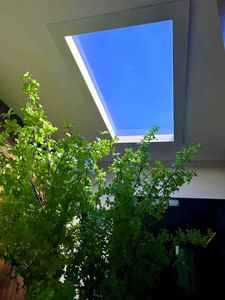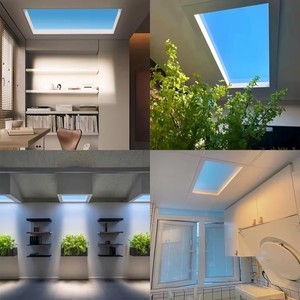
All categories
Featured selections
Trade Assurance
Buyer Central
Help Center
Get the app
Become a supplier

(1523 products available)




















































A virtual skylight is a high-definition display that mimics the appearance of a real skylight. It is designed to be installed indoors and can replicate the look of the sky, clouds, and natural lighting. It is also known as a digital skylight or virtual window. Here are the types of virtual skylights:
LED Skylight
An LED virtual skylight uses light-emitting diodes (LEDs) to create a simulated natural light effect indoors. They are energy efficient, long-lasting and versatile. The lights can be adjusted to different colors and brightness levels to mimic the changing natural light throughout the day. This enhances the ambiance of a room and promotes well-being by reducing the effects of seasonal affective disorder (SAD).
LCD/LED Skylights
These types of virtual skylights employ liquid crystal display (LCD) or light-emitting diode (LED) technology to replicate natural light. They come with adjustable settings that can change the color temperature and brightness. This mimics the natural light variations that occur throughout the day. The skylights can reduce glare and enhance indoor lighting. They provide an energy-efficient alternative to traditional skylights.
OLED Skylights
These are virtual skylights that utilize organic light-emitting diode (OLED) technology to simulate natural lighting and skylights. They produce uniform lighting and offer a high contrast ratio. This results in vibrant colors and deep blacks. OLED virtual skylights provide an immersive and realistic replication of the appearance of a real skylight.
Smart Skylights
These are high-tech virtual skylights that incorporate various advanced technologies. For instance, artificial intelligence, sensors, and connectivity features. They can dynamically adjust the brightness and color temperature to mimic natural sunlight. This provides optimal lighting conditions and enhances the ambiance of a room. Some models can be integrated with smart home systems. This allows for seamless control and customization of the lighting and other environmental settings.
Virtual skylights are high-tech alternatives to traditional skylights. Their features and functions include:
Artificial Lighting
A virtual skylight's primary function is to provide natural light. It does this by imitating sunlight through an advanced lighting system. The system uses LED lights to create the virtual skylight's realistic imagery. It can also employ other technologies to produce light that's as close to natural daylight as possible. This artificial lighting brightens up the space where the virtual skylight is installed. Also, it affects the color of the room to imitate the effects of real sunlight coming from an actual skylight.
High-Definition Display
Another important feature of a virtual skylight is a high-definition display. This display is usually an LCD or an LED screen. The screen is the main component of the virtual skylight. It shows realistic images of the sky, clouds, and sunlight. Thanks to high-definition technology, the images produced are incredibly detailed and vibrant. This makes the illusion of an actual skylight even more convincing. The high-definition display also creates a dynamic and realistic effect by incorporating moving elements like shifting clouds and the sun's path across the sky.
Customization
Many virtual skylights have customizable options. This allows the virtual skylight to be adjusted to fit the specific needs of the room it's installed in. Users can also change its settings to imitate different times of the day and various weather conditions. This feature also allows users to select the type of sky they want, whether it's a clear blue sky, a sunset, or a sunrise.
Smart Technology Integration
Some advanced virtual skylights can be integrated into a home's smart technology system. This allows for seamless control of the virtual skylight through a smartphone or a tablet. The skylight can also be controlled using voice commands if the system supports it. When the virtual skylight is connected to other smart home devices, it creates a fully automated experience. For instance, the skylight can automatically adjust its lighting based on the time of the day or the weather conditions outside.
The use of a virtual skylight can be applied across a wide range of industries and fields. This includes:
Architecture and Construction
Virtual skylights can be used to provide a visualization of how actual solar tubes and skylights will look in a building. This helps clients to see and understand the impact of natural lighting on the design and aesthetics of the building. It also enables architects to make better design choices.
Interior Design
Interior designers use virtual skylights to show clients different lighting options for their interiors. This is especially useful when dealing with spaces where traditional windows are not feasible. The virtual skylight helps in visualizing the effect of natural light coming from above.
Real Estate Development
Developers incorporate virtual skylights into presentations and marketing materials. This allows prospective tenants and buyers to see the potential natural lighting in a space. This is done even before construction is completed. It is also used to highlight the benefits of natural light in residential and commercial properties.
Education and Training
Virtual skylights are used in classrooms and training facilities to create environments that mimic real-world scenarios. This is done to educate students about the importance of natural lighting in design. It also helps them understand the technology behind skylights and solar tubes.
Healthcare
Healthcare facilities use virtual skylights to create calming environments for patients and staff. This is done by simulating the effects of natural light. This helps to improve the well-being and morale of patients and medical practitioners. Virtual skylights can also be used in rooms that lack windows. This helps to create a more pleasant environment for patients.
Workplaces
Companies use virtual skylights to improve the ambiance of office spaces. This is done by incorporating them into the design of spaces that have no access to natural light. This helps to boost the productivity and mood of employees. Virtual skylights can also be used in conference rooms and collaborative spaces to create a sense of connection to the outside world.
Hospitality
In the hospitality industry, virtual skylights are used to enhance the guest experience. This is done by simulating natural lighting in areas such as gyms, spas, and indoor lounges. This creates a more relaxing and enjoyable environment. Virtual skylights can also be used in the design of unique dining experiences.
There are some things to consider when choosing a virtual skylight to make sure the ideal product for your needs is found. Here are some of them:
Consider the Type of Virtual Skylight
It is important to choose the right type of virtual skylight. The options available vary by size, technology used, and features. Some types include a virtual skylight with LED lights, with an LCD screen, and a digital virtual skylight.
Consider the Size and Resolution
The size should be proportional to the size of the room and the resolution. A virtual skylight with high resolution offers clearer and more detailed images. This makes the simulation of the sky more realistic.
Consider the Technology Used
Various technologies are used to create virtual skylights, such as LCD, LED, and OLED. Skylights enhance natural lighting by mimicking the appearance of the sky. LED panels are energy efficient and have long-lasting durability. However, they may not offer the best image quality. OLED panels have contrast and color reproduction. They are used where high-quality images are needed. Consider the advantages of each technology and choose the one that meets the lighting requirements.
Consider the Installation Process
The installation process should be straightforward. This minimizes additional costs and time. Some virtual skylights require professional installation, while others are DIY friendly.
Consider the Maintenance Requirements
This includes the cleaning and updating process. Some virtual skylights have easy-to-maintain features, while others require high maintenance. Choose a skylight that meets the required maintenance level.
Energy Efficiency
Energy efficiency should be prioritized when choosing a virtual skylight. This is because it reduces operating costs. It also indicates the long-term value of the product. Virtual skylights that are energy efficient consume less power. This is important when the skylight is used frequently. Look for options that have energy-efficient certifications or are designed with cutting-edge technologies. Such technologies minimize energy consumption.
Customer Support and Warranty
When choosing a virtual skylight, it is important to look at the offered customer support and warranty options. A reliable warranty protects the investment for several years. This covers any potential issues that may arise during the skylight's lifespan. Look for manufacturers who offer comprehensive warranties. This shows confidence in their products. Consider the terms and conditions of the warranty to make sure they are favorable.
Q: What is a virtual skylight?
A: A virtual skylight is an artificial lighting solution that uses video projection to create the appearance of an actual skylight. It mimics natural light and the changing views of the sky, thereby giving the impression of an overhead window.
Q: How does a virtual skylight work?
A: Virtual skylights use LCD or LED screens to display dynamic images of the sky, clouds, and sunlight. This imagery is combined with high-quality lighting to replicate the effects of natural daylight coming from above.
Q: What are the benefits of virtual skylights?
A: Benefits include the ability to bring the illusion of natural light into spaces without real skylights, improving mood and productivity, and offering customizable imagery. They are also cost-effective and easy to install.
Q: Where can virtual skylights be used?
A: They can be used in a variety of settings including offices, healthcare facilities, retail environments, and any interior spaces that require natural light enhancement. Virtual skylights are particularly beneficial in windowless rooms.
Q: Do virtual skylights require special installation?
A: Virtual skylights are straightforward to install as they require no structural alterations like actual skylights. Installation typically involves mounting the lighting panels or screens in suitable locations to ensure visibility and electrical connections.